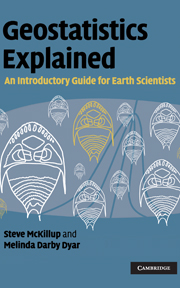Book contents
- Frontmatter
- Contents
- Preface
- 1 Introduction
- 2 “Doing science”: hypotheses, experiments and disproof
- 3 Collecting and displaying data
- 4 Introductory concepts of experimental design
- 5 Doing science responsibly and ethically
- 6 Probability helps you make a decision about your results
- 7 Working from samples: data, populations and statistics
- 8 Normal distributions: tests for comparing the means of one and two samples
- 9 Type 1 and Type 2 error, power and sample size
- 10 Single-factor analysis of variance
- 11 Multiple comparisons after ANOVA
- 12 Two-factor analysis of variance
- 13 Important assumptions of analysis of variance, transformations and a test for equality of variances
- 14 Two-factor analysis of variance without replication, and nested analysis of variance
- 15 Relationships between variables: linear correlation and linear regression
- 16 Linear regression
- 17 Non-parametric statistics
- 18 Non-parametric tests for nominal scale data
- 19 Non-parametric tests for ratio, interval or ordinal scale data
- 20 Introductory concepts of multivariate analysis
- 21 Introductory concepts of sequence analysis
- 22 Introductory concepts of spatial analysis
- 23 Choosing a test
- Appendices
- References
- Index
6 - Probability helps you make a decision about your results
Published online by Cambridge University Press: 05 June 2012
- Frontmatter
- Contents
- Preface
- 1 Introduction
- 2 “Doing science”: hypotheses, experiments and disproof
- 3 Collecting and displaying data
- 4 Introductory concepts of experimental design
- 5 Doing science responsibly and ethically
- 6 Probability helps you make a decision about your results
- 7 Working from samples: data, populations and statistics
- 8 Normal distributions: tests for comparing the means of one and two samples
- 9 Type 1 and Type 2 error, power and sample size
- 10 Single-factor analysis of variance
- 11 Multiple comparisons after ANOVA
- 12 Two-factor analysis of variance
- 13 Important assumptions of analysis of variance, transformations and a test for equality of variances
- 14 Two-factor analysis of variance without replication, and nested analysis of variance
- 15 Relationships between variables: linear correlation and linear regression
- 16 Linear regression
- 17 Non-parametric statistics
- 18 Non-parametric tests for nominal scale data
- 19 Non-parametric tests for ratio, interval or ordinal scale data
- 20 Introductory concepts of multivariate analysis
- 21 Introductory concepts of sequence analysis
- 22 Introductory concepts of spatial analysis
- 23 Choosing a test
- Appendices
- References
- Index
Summary
Introduction
Most science is comparative. Earth scientists often need to know if a particular phenomenon has had an effect, or if there are differences in a particular variable measured at several different locations. For example, what is the permeability of sandstone with and without carbonate impurities? How does turbidity vary across a glacial lake? How well does the distribution of dew point temperature predict rainfall? But when you make these sorts of comparisons, any differences among areas sampled or manipulative experimental treatments may be real or they may simply be the sort of variation that occurs by chance among samples from the same population.
Here is an example of commercial importance. Most diamonds are mined from kimberlite deposits, which are volcanoes that have risen from great depths in the Earth's mantle at high speed. Sometimes, the kimberlite brings along diamonds that have formed at high pressures and temperatures. But not all kimberlites contain diamonds, and finding them within these rocks is quite difficult.
Fortunately, many kimberlites contain large amounts of the mineral garnet. A prospector noted that the garnets present in diamond-rich kimberlites were slightly darker than those in kimberlites lacking diamonds, and subsequent research suggested that the change in color was caused by the presence of small amounts of oxidized Fe, or Fe3+. To test if oxidized garnets could be used to predict the presence of diamonds, the prospector collected 14 garnet samples: seven from diamond-bearing deposits of kimberlite, and seven from kimberlite without diamonds (Table 6.1), and measured their Fe3+ content.
- Type
- Chapter
- Information
- Geostatistics ExplainedAn Introductory Guide for Earth Scientists, pp. 51 - 65Publisher: Cambridge University PressPrint publication year: 2010

